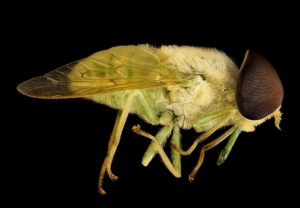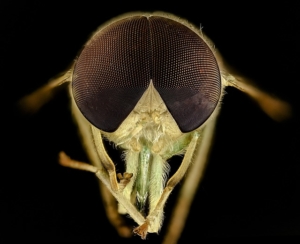While mosquitoes are likely the best known of the biting flies, there are numerous other species that bite as well.

Thankfully, in Colorado, mosquitoes are the only species known for transmitting human diseases. There are however biting flies that can transmit animal diseases. To humans, the often more important factor in fly bites is that they are often painful and produce swelling along with severe itching due to the saliva injected at the time of the bite.
Black Flies
The most common of the biting flies, adult black flies can be a serious annoyance. They typically feed on birds and livestock; however, they may also bite humans. Black fly attacks are typically concentrated in livestock and humans around the ears and head. Beyond the typical swelling and itching of a fly bite, black flies can also cause allergenic asthma, nausea, and systemic effects, a condition known as “black fly fever”.
Animals may become extremely annoyed with black flies and exhaust themselves in their attempts to get away from the flies. Horses, cattle, and pigs are also susceptible to vesicular stomatitis, which is transmitted by black flies. Black flies are migratory and commonly fly many miles from larval breeding sites. A rapid life cycle of roughly three weeks from eggs being laid to mature adults is common in black flies. Two to four generations are produced annually.
Populations can increase rapidly and adults live an average of two weeks. All black flies require cool, running water in which to develop. Sites that have pebbled or rocked bottoms are a favorite of black flies. Larvae attach themselves to the rocks and other materials while feeding on the organic particles filtered from the flowing water. Unusually heavy and sustained spring run-off may result in outbreaks of black flies. Approximately 40 species of black flies occur in Colorado.
 Stable Flies – aka “Biting House Fly”
Stable Flies – aka “Biting House Fly”
A look-alike to the common house fly, stable flies have mouthparts adapted to biting.
The name stable fly comes from their reputation for being a major pest of confined livestock; however, they will attack nearly any warm-blooded animal. Females live up to a month and may require several blood meals in that time in order to produce and continue producing eggs. Humans are typically attacked by stable flies around the ankle region. So far, it does not appear that they are an important vector of any human diseases.
Deer Flies
Moderate in size, deer flies are daytime biters that inflict a painful bite, often drawing blood in the process. Eggs are laid on grasses and other vegetation near ponds or other permanent water sources.
Adults are present for two to three weeks. Deer flies have a one-year life cycle. Deer flies are often noted for their large colored eyes and patterned bodies and wings. A close relative to the deer fly is the horse fly, which is somewhat larger, but typically exhibits similar habits. Horseflies although capable of biting humans are less likely to do so than deer flies. Insect repellents are typically not effective in deterring deer fly bites.